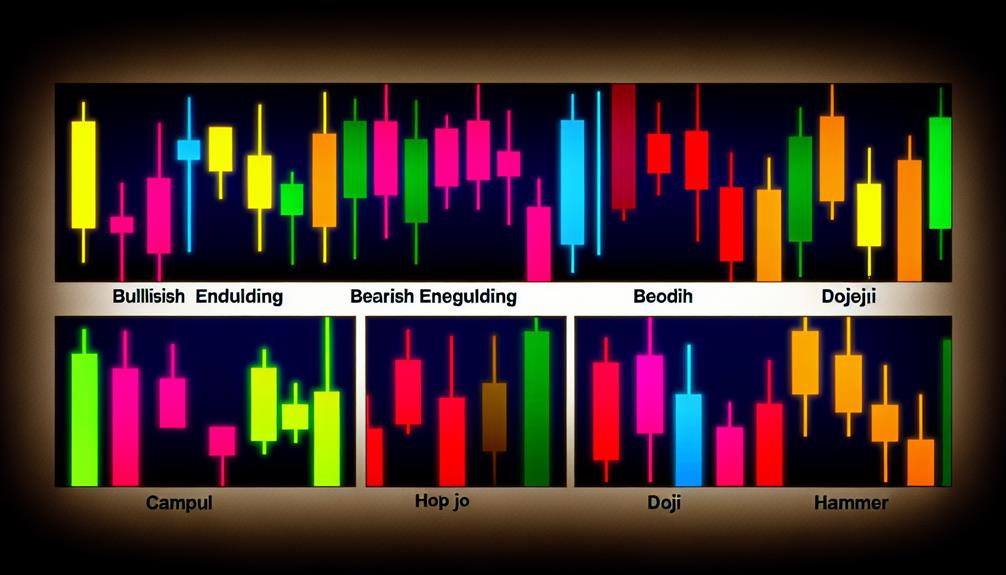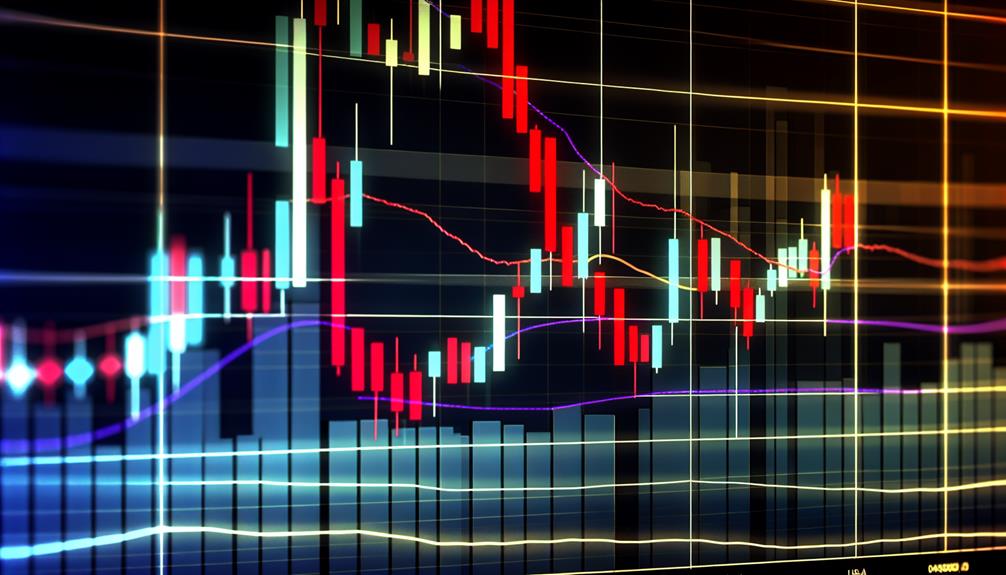When you start exploring crypto charts, it can feel overwhelming with the variety of formats and indicators available. You'll encounter line, bar, and candlestick charts, each serving a different purpose in understanding market dynamics. It's vital to grasp how timeframes and candlestick patterns work, as they can greatly influence your trading decisions. But what are the key elements that truly matter, and how can they guide your strategy in this volatile environment? You might be surprised at how a few simple tools and concepts can transform your approach.
Understanding Crypto Chart Basics

Understanding crypto charts is essential for anyone looking to navigate the volatile world of digital currencies. These charts provide a visual representation of price movements, allowing you to analyze trends and make informed decisions. One of the key concepts you'll encounter is chart timeframes. Depending on your trading strategy, you might choose different timeframes, such as one minute, hourly, daily, or weekly. Each timeframe offers unique insights into market behavior, affecting your understanding of crypto volatility.
When you look at a shorter timeframe, like the one-minute chart, you'll see rapid fluctuations that indicate high volatility. This can be useful for day traders seeking quick profits but may overwhelm those who prefer a longer-term approach. On the other hand, longer timeframes, such as daily or weekly charts, smooth out the noise, revealing broader trends that can inform your investment strategy over time.
Additionally, it's important to recognize that crypto volatility can be both an opportunity and a risk. The price of cryptocurrencies can swing dramatically within a short period, and understanding how to read these charts helps you identify potential entry and exit points. By analyzing patterns and indicators, you can develop a clearer picture of market sentiment and potential future movements.
Types of Crypto Charts
When examining the different types of crypto charts, you'll encounter three primary formats: line charts, bar charts, and candlestick charts. Each type offers a unique perspective on price action and can cater to various trading strategies.
Line charts are the simplest form, connecting closing prices over specified time frames. They provide a clear visual of historical data trends but lack depth regarding market sentiments or price fluctuations throughout the trading period.
Bar charts, on the other hand, display more information. Each bar represents a specific time frame, indicating the open, high, low, and close prices. This format allows traders to analyze price action more effectively and can be beneficial when employing technical indicators, as it highlights potential reversals and continuation signals.
Candlestick charts take it a step further by visually representing price action with colored candles. Each candle conveys the same information as bar charts but does so in a more intuitive way, making it easier to spot patterns and market sentiments. They can also incorporate chart overlays, enhancing analysis through additional context.
Additionally, point charts and area charts can be useful for specific trading strategies. Point charts plot individual price points without connecting them, focusing solely on price action. Area charts, conversely, fill the space beneath the line, emphasizing the volume of price changes over time.
Reading Candlestick Patterns

To effectively read crypto charts, it is crucial to understand the components of candlesticks, including their open, close, high, and low prices. Familiarizing yourself with common candlestick patterns can provide insights into market behavior and trends. By interpreting these patterns accurately, you can make more informed trading decisions based on market sentiment.
Understanding Candlestick Components
Reading candlestick patterns can reveal valuable insights into market sentiment and price action. Understanding candlestick anatomy is essential for your analysis. Each candlestick consists of a body and wicks. The body size indicates the difference between opening and closing prices, while the color meanings—red for bearish and green for bullish—reflect market psychology.
Wick significance shouldn't be overlooked; longer wicks can show rejection of prices and hint at volatility. Pay attention to the time frames you're analyzing since candlestick data can vary considerably across intervals, influencing your interpretation.
Bullish signals often appear as strong green candles with minimal wicks, suggesting buyers dominate. Conversely, bearish signals might present as red candles, indicating sellers are in control. Volume impact is another key factor; increased volume during a candlestick formation can validate the strength of the observed pattern.
Additionally, be aware of potential reversal patterns. These formations can signal shifts in market sentiment, prompting traders to adjust their strategies. By grasping these components, you'll enhance your ability to read crypto charts effectively and make informed trading decisions.
Common Candlestick Patterns
A variety of common candlestick patterns can greatly enhance your ability to interpret market movements. One of the most notable patterns is the bullish engulfing, indicating a potential reversal in a downtrend. Conversely, the bearish harami suggests a potential downturn after an uptrend.
Patterns like the doji star, morning star, and evening star provide insights into market indecision and potential reversals, with the morning star indicating bullish sentiment and the evening star signaling bearishness. The shooting star and hanging man patterns can also suggest reversals, depending on their position in the trend.
The hammer candle and inverted hammer are vital for identifying potential bullish reversals, while the three white soldiers and three black crows patterns signify strong momentum in either direction.
Additional patterns, such as spinning tops, indicate indecision, and tweezer tops and bottoms highlight potential reversals at key levels. Recognizing these candlestick patterns can considerably improve your analysis of crypto charts, helping you make informed trading decisions based on market sentiment and price action. Understanding these patterns is essential for any trader looking to navigate the volatile crypto landscape effectively.
Interpreting Market Trends
While analyzing candlestick patterns is essential for understanding market trends, it's important to recognize how these formations reflect trader sentiment and momentum. By examining price action, you can identify bullish divergence and bearish divergence, which signal potential reversals in market sentiment. For instance, a bullish divergence occurs when prices make lower lows while momentum indicators show higher lows, indicating increasing buying pressure.
Integrating technical analysis with candlestick patterns allows you to derive insights about market psychology. Traders often react to news impact, making certain candlestick formations more significant based on recent developments. Understanding these patterns can inform your trading strategies and enhance your risk management approach.
For instance, a strong bullish engulfing pattern might suggest a shift toward positive market sentiment, prompting you to contemplate entering a long position. Conversely, a bearish engulfing pattern could indicate impending downward pressure, leading you to reassess your positions.
Analyzing Support and Resistance
To effectively analyze support and resistance, you need to identify key levels where price movements tend to bounce or reverse. Understanding the significance of trend lines can also provide clarity on market direction and potential breakout points. Additionally, incorporating volume analysis helps you gauge the strength of these levels, offering deeper insights into market dynamics.
Identifying Key Levels
Identifying key levels in crypto charts is essential for making informed trading decisions, as these levels often indicate where price movements may change direction. Understanding the psychology behind these key levels can enhance your trading strategies. Support zones are areas where buying pressure tends to emerge, while resistance tactics highlight price ceilings. Recognizing these levels can help you develop effective breakout strategies.
To illustrate this concept, consider the following table:
| Key Level Type | Characteristics | Market Implications |
|---|---|---|
| Support Zone | Indicates buying pressure | Potential price rebounds |
| Resistance Tactic | Shows selling pressure | Possible price reversals |
| Psychological Barrier | Significant historical levels | Triggers strong market sentiment |
Utilizing tools like Fibonacci retracement can help identify these key levels based on historical significance in price action. By analyzing order flow around these levels, you can better gauge market sentiment and predict potential shifts. Ultimately, effectively identifying and responding to key levels will enhance your trading decisions, allowing you to navigate the complexities of the crypto market more adeptly.
Trend Lines Importance
Trend lines play an important role in analyzing support and resistance in crypto charts, as they visually represent the prevailing market direction and help traders identify potential reversal points. Understanding trend line significance is vital, as it allows you to differentiate between upward, downward, and horizontal trends. When drawing trendlines, guarantee they connect at least two significant price points, providing a clearer picture of market dynamics.
There are various trend line types, and each serves different analytical purposes. Implementing trend line strategies can help you gauge market sentiment and forecast future price movements. Trend line breakouts often signal strong momentum shifts, while trend line validation confirms that the established lines hold weight in the current market.
Additionally, the psychology behind trend lines can influence trading decisions. Traders may react to trend line applications by placing buy or sell orders based on their alignment with established support and resistance levels. By mastering these concepts, you can enhance your trading strategies and make more informed decisions, ultimately improving your chances of success in the volatile crypto market.
Volume Analysis Insights
Analyzing volume alongside trend lines provides deeper insights into support and resistance levels in crypto markets. By examining volume indicators, you can identify significant volume spikes that often precede price movements. Understanding trading volume helps in determining whether a price level will hold or break.
A few key concepts can enhance your volume analysis:
| Concept | Description |
|---|---|
| Volume Trends | Observing the general direction of trading volume over time. |
| Volume Patterns | Recognizing formations that indicate potential reversals or continuations. |
| Support Levels | Identifying price points where increased buying volume may halt a decline. |
| Resistance Levels | Noting price points where selling volume often overwhelms buying. |
| Volume Confirmation | Using volume spikes to confirm breakout or breakdown signals. |
When you analyze these aspects, you're better equipped to make informed trading decisions. For example, if a price breaks through a resistance level but is accompanied by low trading volume, it may indicate a false breakout. Consequently, incorporating volume analysis into your crypto trading strategy is essential for recognizing reliable support and resistance levels.
Using Moving Averages

One of the most effective ways to gauge market sentiment is by utilizing moving averages, which smooth out price data to reveal underlying trends. You can implement various moving average strategies, including simple moving averages (SMAs) and exponential moving averages (EMAs). While SMAs calculate the average price over a specific time frame, EMAs give more weight to recent prices, making them more responsive to market volatility.
Incorporating moving averages into your analysis allows for better signal confirmation, particularly through crossover signals. When a shorter-term moving average crosses above a longer-term moving average, it often indicates a potential upward trend, while the reverse can signal a downward shift. These crossover signals act as lagging indicators, meaning they follow price trends rather than predict them. However, their reliability increases when used in conjunction with other technical analysis tools.
The choice of time frames is vital when applying moving averages. For short-term trading, you might prefer a 10-day or 20-day moving average, while longer-term investors may opt for 50-day or 200-day averages. By aligning your moving average selections with your trading strategy, you can enhance your trend-following approach and better navigate market fluctuations.
Ultimately, moving averages provide essential price smoothing, helping you to filter out noise and focus on significant market trends. By understanding and applying these concepts effectively, you'll gain a clearer perspective on price movements and potential trading opportunities.
Identifying Trends and Signals
While maneuvering through the complexities of crypto markets, identifying trends and signals becomes essential for making informed trading decisions. You'll want to recognize key indicators that can suggest potential price movements. For instance, trend reversals often signal shifts in market sentiment, which can be detected through momentum indicators and oscillators. A bullish divergence, where price makes lower lows while indicators show higher lows, can indicate potential upward momentum. Conversely, a bearish divergence may suggest impending downward trends.
Understanding market psychology through sentiment analysis helps you gauge the overall mood of traders, which can influence market movements. When you analyze chart timeframes, different patterns can emerge that may not be visible in a single timeframe. For example, a Fibonacci retracement can provide levels of potential support and resistance, aiding in identifying where price may reverse.
Additionally, volume spikes often accompany significant price movements and can reinforce the validity of a trend. Here's a quick overview of these concepts:
| Indicator Type | Description | Market Implication |
|---|---|---|
| Trend Reversal | Change in direction of price movement | Potential buy/sell signal |
| Bullish Divergence | Price drops, indicators rise | Possible upward trend |
| Bearish Divergence | Price rises, indicators drop | Possible downward trend |
| Fibonacci Retracement | Levels of support/resistance | Identifying reversal points |
| Volume Spikes | High trading volume | Confirmation of trend strength |
Tools for Chart Analysis

Utilizing the right tools for chart analysis can greatly enhance your ability to interpret market trends and signals. In the world of cryptocurrency, having access to effective analysis tools is essential for making informed trading decisions. Here are some key tools you should consider:
- Charting Software: Tools like TradingView or Coinigy allow for extensive charting capabilities, helping you visualize price movements effectively.
- Technical Indicators: Utilize indicators such as Moving Averages or RSI to assess market momentum and potential price reversals.
- Trading Platforms: Platforms like Binance or Coinbase Pro offer integrated charting features that facilitate immediate market analysis.
- Price Alerts: Set up alerts for specific price levels, so you're notified of notable changes without constantly monitoring charts.
- Chart Overlays: Use overlays to compare multiple assets or indicators on the same chart, enhancing your analytical capabilities.
These tools not only aid in data visualization but also provide access to historical data, making your market analysis more robust. When selecting software, consider conducting tool comparisons to identify the features you value most. Whether you're analyzing trends or looking for entry and exit points, the right combination of charting software and technical indicators can greatly impact your trading success. Remember, the goal is to leverage these tools to gain a clearer picture of the market, enabling you to make timely and informed decisions.
Frequently Asked Questions
What Timeframes Should I Use for Crypto Chart Analysis?
When analyzing crypto charts, consider using shorter timeframes for short-term strategies and longer ones for long-term perspectives. This approach helps you capture immediate trends while also understanding broader market movements over time.
How Do News Events Impact Crypto Chart Trends?
News events considerably shape market sentiment, triggering price spikes or trend reversals. Regulatory impacts and event timing amplify news volatility, while social media influences investor behavior, creating unpredictable patterns that can alter chart trends dramatically.
Can I Use Traditional Stock Analysis Techniques on Crypto Charts?
Yes, you can use traditional stock analysis techniques on crypto charts. Chart patterns and technical indicators often apply similarly, but remember, crypto markets are more volatile, so adjust your strategies accordingly to account for that unpredictability.
What Are the Risks of Relying Solely on Chart Analysis?
Relying solely on chart analysis exposes you to chart limitations and emotional bias. Market volatility can distort technical indicators, while neglecting fundamental analysis and trading psychology may lead to misguided decisions and increased risk.
How Often Should I Update My Analysis Based on Market Changes?
You should adjust your analysis frequency based on market volatility. Frequent updates help you stay aware of rapid changes, ensuring your strategy remains relevant. Regularly revisiting your analysis keeps you aligned with the evolving market landscape.
Conclusion
To sum up, mastering crypto charts is essential for making informed trading decisions. Did you know that over 70% of traders rely on technical analysis, primarily through charts, to navigate the volatile market? By understanding the various chart types, reading candlestick patterns, and recognizing support and resistance levels, you can greatly enhance your trading strategy. Utilizing these tools effectively can empower you to make more calculated decisions and better anticipate market movements.
